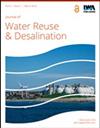Activation of peroxymonosulfate by CuCo2O4 nano-particles towards long-lasting removal of atrazine
IF 2.3
Q2 Environmental Science
引用次数: 25
Abstract
The effect of peroxymonosulfate (PMS) activated by nanocrystalline CuCo2O4 (NPS) on removal of atrazine (ATZ) was studied. First, the main experimental parameters were studied, including CuCo2O4 dose, PMS dose, initial pH value, and co-existing ion. The removal of ATZ (>99%) was attained under the optimal conditions (i.e., 150 mg/L CuCo2O4, 0.2 mM PMS, 5 mg/L ATZ, initial pH value of 6.8, and reaction time of 30 min). However, the removal of ATZ only reached 20.9% in the PMS alone system and there was no significant ATZ removal when adding CuCo2O4 alone into the solution, proving the good performance of the CuCo2O4/PMS system. Furthermore, reusability of CuCo2O4 was tested through five consecutive runs. To confirm which main active radicals were responsible in the system, two radical quenching experiments were carried out and electron paramagnetic resonance (EPR) was tested. In addition, the characterization of fresh and reacted CuCo2O4 NPs was tested by SEM, TEM, EDS, XRD, and XPS. Subsequently, based on the characterization of CuCo2O4 NPs and identification of radicals, ≡Cu2+/ ≡ Cu+ and ≡Co3+/ ≡ Co2+ were considered to be the main catalytic species, while the synergistic effect of Cu and Co played a crucial role. Finally, the degradation pathway of ATZ was proposed.CuCo2O4纳米粒子活化过氧单硫酸盐对阿特拉津的长效去除
研究了纳米晶CuCo2O4 (NPS)活化过氧单硫酸盐(PMS)去除阿特拉津(ATZ)的效果。首先,研究了CuCo2O4剂量、PMS剂量、初始pH值、共存离子等主要实验参数。在CuCo2O4浓度为150 mg/L、PMS浓度为0.2 mM、ATZ浓度为5 mg/L、初始pH值为6.8、反应时间为30 min的条件下,ATZ的去除率达到99%(>)。而单独加入PMS时,ATZ去除率仅为20.9%,单独加入CuCo2O4时,ATZ去除率不明显,证明了CuCo2O4/PMS体系的良好性能。此外,通过连续五次运行测试了CuCo2O4的可重用性。为了确定系统中主要活性自由基的作用,进行了两次自由基猝灭实验和电子顺磁共振(EPR)测试。此外,采用SEM、TEM、EDS、XRD、XPS等手段对新鲜CuCo2O4 NPs和反应后的CuCo2O4 NPs进行了表征。随后,基于CuCo2O4 NPs的表征和自由基的鉴定,≡Cu2+/≡Cu +和≡Co3+/≡Co2+被认为是主要的催化物质,而Cu和Co的协同作用起着至关重要的作用。最后,提出了ATZ的降解途径。
本文章由计算机程序翻译,如有差异,请以英文原文为准。
求助全文
约1分钟内获得全文
求助全文
来源期刊

Journal of Water Reuse and Desalination
ENGINEERING, ENVIRONMENTAL-WATER RESOURCES
CiteScore
4.30
自引率
0.00%
发文量
23
审稿时长
16 weeks
期刊介绍:
Journal of Water Reuse and Desalination publishes refereed review articles, theoretical and experimental research papers, new findings and issues of unplanned and planned reuse. The journal welcomes contributions from developing and developed countries.
 求助内容:
求助内容: 应助结果提醒方式:
应助结果提醒方式:


